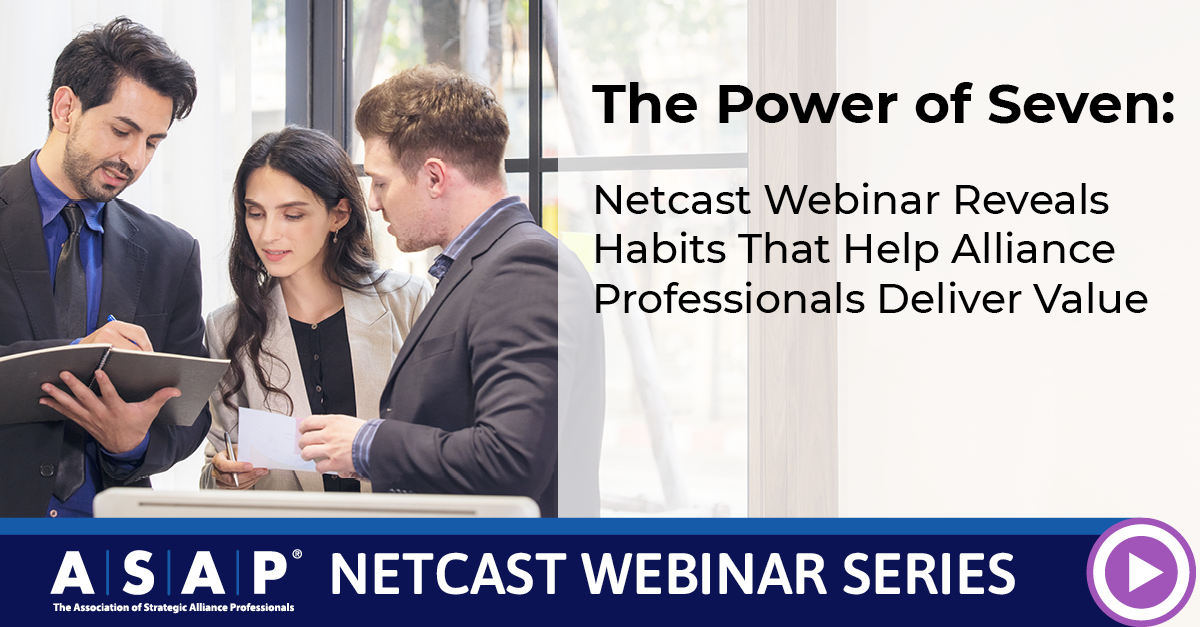The Power of Seven: Netcast Webinar Reveals Habits That Help Alliance Professionals Deliver Value
Posted By Jon Lavietes, Thursday, February 18, 2021
Yes, 2020 was a rough year for most, but if there was any consolation for alliance managers it’s that the value of partnerships has never been clearer than in these pandemic circumstances. Of course, with increased scrutiny comes more pressure on alliance professionals to be on their game at all times.
Veteran independent alliance management experts and longtime ASAP sponsors The Rhythm of Business continued ASAP’s Netcast Webinar Series on February 11 by outlining “Seven Habits of Highly Effective Alliance Professionals” that will guarantee the alliance practice is not just holding the attention of senior leadership and other stakeholders but wowing them, too.
Jeff Shuman, CSAP, principal at The Rhythm of Business, broke down the seven steps to a creating an effective and essential alliance function:
- Enhance value, manage risk – Create and recognize opportunities, capture new intellectual property, look for ways to improve cost structures for all parties, monitor obligations and restrictions, plan decisions to avoid delays, and conduct scenario planning.
- Manage/engage stakeholders – Demonstrate what’s in it for them, help them reduce the cost of time, and increase collaborative behaviors.
- Bridge differences – Create that “one-team” mentality and understand how strategy, culture, organization structure, business models, processes, and competitive issues affect alliances.
- Interpret insights – Inquire about ongoing changes in partner company strategy, operations, personnel, and other factors that can impact alliances.
- Resolve problems – Ensure fair and efficient distribution of value across partners and resolve problems before they erode value.
- Operational excellence – Establish and implement planning, governance and decision-making, measurement and improvement, communication, and reporting processes that help stakeholders bring their best, reduce friction, and incorporate partners into how work gets done.
- Publish your work – Use a digital platform to make your work visible, tangible, measurable, understood, and appreciated.
Publish or Perish: Alliance Managers Must Broadcast Their Contributions
Many of these tenets represent familiar challenges that are frequently the subject of ASAP members’ war stories. However, the last one wasn’t as readily apparent and drew significant curiosity from attendees. For many years, the alliance management community has wrestled with demonstrating value (see “Where’s the Value?,” Strategic Alliance Quarterly, Q1 2021). Shuman noted that having all of your KPI metrics, agendas, and ongoing activities centralized and visible to all stakeholders could go a long way in illustrating the utility of what alliance managers do, much of which is often conducted behind the scenes.
“As my partner Jan likes to say, ‘You’ve gotta toot your own horn,’” said Shuman.
Jan Twombly, CSAP, president of The Rhythm of Business, delved deeper into the benefits of having a digital alliance management platform. Unlike most other functions, alliance management hasn’t yet normalized the use of specialized software portals tailored to its practice, instead relying on old-school methods like personal dashboards, spreadsheets, and email. Manual reporting often results in lost files and critical activities falling through the cracks, especially since alliance tracking documents are rarely integrated with key apps in the enterprise. Moreover, without a centralized platform, there’s no historical record.
“You can’t get that overarching portfolio view,” said Twombly.
A modern alliance management software platform promotes transparency, gets everyone on the same page, and enables all stakeholders to pull customized reports that contain only the information and metrics that matter to them.
“When you digitize, you have a single version of the truth,” Twombly added.
Shared Common Language Helps Paint Pretty Mental Picture
Twombly broke the sixth habit, operational excellence, into three components: 1) provide visibility and transparency by creating a common language with shared meaning, so that “when I say something, you have the same mental picture that I have, and that is so critically important because otherwise we are just talking past each other”; 2) structure data-driven learning processes that promote experimentation and innovation; and 3) digitize information and workflows to drive efficiency, consistency, and visibility of processes and results.
Gaining and interpreting insights that could be invaluable to the organization and its alliances might be easier said than done, but it is an important opportunity for alliance managers to add and demonstrate their value if they get it right. They should take it upon themselves to be the expert on the industry, company, and partners involved in the partnerships they oversee. They must be a collaboration’s ombudsman, representing the company to the partner and the partner’s interest to the company. Most critical, they must recognize the financial drivers of alliances and track the metrics that are most important to senior leaders.
“Be the expert,” advised Twombly. “What’s going on out there, and how does it impact your company and the partner?”
Over the course of the webinar, Shuman and Twombly donned the scuba gear and took listeners on a deeper dive into a few more of these seven habits of effective alliance managers. ASAP members can always access these insights, as well as many more past Netcast Webinars, in ASAP’s Member Resource Library. Watch “Seven Habits of Highly Effective Alliance Professionals” today and find out how to prioritize stakeholders and identify which ones require a deeper level of engagement. And more webinars are in the offing! Sign up for “Improving Alliance Performance—New Tools for Alliance Managers from the M&A Toolbox” today!

